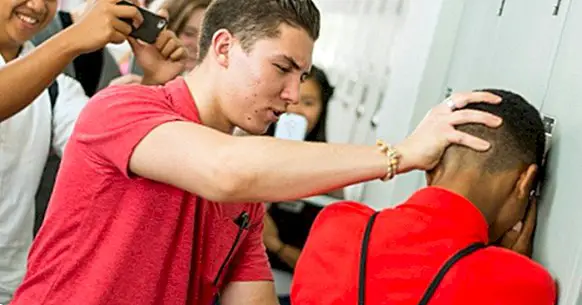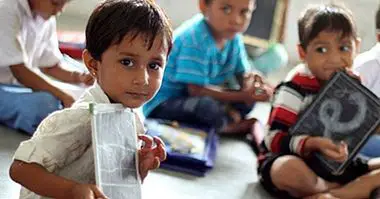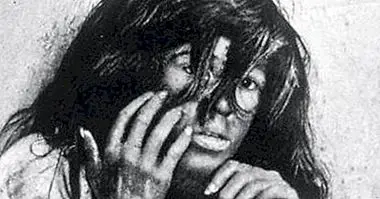28 questions about bullying to detect violence in class
Bullying is a phenomenon that, although it has probably existed since antiquity, has not received much media attention until relatively recently. We are facing an act of abuse and continued harassment over time it can have devastating effects on those who suffer from it, both physically and psychologically.
Often the suffering of children and young people suffering from bullying remains hidden either by fear or shame on the part of these, by the law of silence that is often frequent in the classroom on the subject or even lack of capacity, tools or knowledge by responsible adults to capture or treat acts of aggression (unfortunately, sometimes without even being ignored and undervalued). In this article, a series of possible questions about bullying that could help detect the existence of cases in the school environment.
- Related article: "Bullying: analyzing bullying through mimetic theory"
Bullying: the basic concept
We understand bullying or bullying to all that type of relationship between peers in which a relationship of inequality is established in which in which one or several subjects commit any type of voluntary act that seeks to harm, vex or harm in any way to another or other individuals.
The one or the assaulted ones is submitted in some way by the aggressors , which act persistently over time. These abusive relationships occur either within the school context or between subjects related to their coexistence in an educational institution.
The abusive acts that take place can be of very diverse nature and be carried out both directly (attacking the subject attacked in an obvious way) and indirectly (promoting that it be excluded, discrediting or vexing it through networks). Bullying can include physical aggression, insults or abuse, theft, active marginalization towards the minor, publication and sending materials on the networks in which they are criticized or directly attacked (including videos), coercion, identity theft or even induction to suicide.
In this area it is important to bear in mind that not only there are attacked and aggressor, but there are also witnesses of the acts that can end up promoting or preventing the harassment or that simply do not get involved. Also the teachers and the educational institution, as well as the families, have an important role. You can work from very different perspectives (prevention and treatment of existing cases being a priority) and with the different agents involved.
But to be able to work with situations of bullying and stop them first it is necessary to be able to detect the existence of cases. Multiple organisms use for it different tests and questions that can be used to achieve this detection .
- Maybe you're interested: "The 5 types of bullying or bullying"
Questions about bullying
Next, a series of questions about bullying are established, which can be used to identify cases of abuse in the school, to prevent them or to learn about attitudes and beliefs regarding bullying (some of which have been extracted from tests proposed by the school. organizations such as the Ministry of Education).
These questions can be made to the class group as a whole, to individual students (be witnesses, assaulted or aggressors) or even teachers and family members. They can be done through a questionnaire (to be able to be anonymous) or through an individual interview.
1. Could you tell me what it is like to be in your class?
This question can be used to visualize the general climate that is breathed in the class and if the minor in question feels comfortable in it or not.
2. How do you feel about your classmates?
Although similar to the previous one, this time the emphasis on the student's relationship with the rest of classmates . Depending on the answer, you can infer whether or not there are concrete problems in this regard.
3. Have you noticed any conflict between some students in your class?
Although it may be normal that there are small conflicts between partners, this question allows the subject to evaluate if they are frequent or if they have frequent protagonists.
4. Do you know of someone who has been assaulted or insulted at some time by a classmate or student?
This question allows the subject to indicate if he has ever visualized a case or if he has been able to witness it at present.
5. Do you know what bullying is? Could you explain what it is or give me an example?
Knowing what bullying is is essential to be able to detect a case , with which the knowledge of the concept is very important. Both in students and teachers.
6. What types of bullying do you know and what do you think of them?
Although today bullying is a topic that is often talked about, in many cases it is not known everything that involves or is not considered an act that actually is (for example, promoting the marginalization of a person in concrete or create a WhatsApp group to laugh at a person), only physical harassment being considered as such.
- Maybe you're interested: "The KiVa method, an idea that is ending bullying"
7. Do you think it is common to use new technologies and social networks to harm other people?
Nowadays, children and young people tend to be connected to networks more and more in advance, and can report the existence of cases of harassment derived from their use.
8. Do you know of a case in which a student has been assaulted or insulted frequently, or attacked through the networks?
Going into matter, the subject that is questioned can answer and indicate their knowledge or ignorance about current or past cases.
9. Do you think aggression among students is a problem at this center?
The students are those who see and experience these situations first-hand , so that they can easily indicate if any type of harassment is taking place. This question can also be asked to teachers or family members.
10. Has it ever happened to you?
A direct question, but that will allow the child to express if he has lived some similar experience or if he is living it nowadays.
11. Have you ever felt intimidated in class or threatened?
Bullying is very common in cases of bullying. It also allows to detect the presence of dominance attitudes in some students.
12. Have you ever been robbed or hidden? Do you know anyone who happened to him?
What some students may find a game may hide the intention to vex or generate deep suffering for a specific person. In the case of robbery, you are also robbed of assets or property and sometimes violently.
13. Does anyone in the class have a nickname?
Demeaning mottos are one of the most common and frequent types of harassment.
14. Could you tell me what happened / happened?
Assuming that the answer to any of the above is positive, it is important to know what happened.
15. Is it something continued over time?
It is necessary to identify if the problem or aggression occurred at a specific time or is something frequent, or if it is still valid.
16. Could you tell me when and where the problem started?
Assuming that the answer to any of the above is positive, contextualize the situation can help to work and understand how established is the problem or the type of harassment suffered .
17. How do you think someone would feel in that situation?
In this question, it is sought that the person who is asked to try to put himself in the place of someone who suffers harassment. It can be preventive by reflecting on the situation of those attacked.
18. What consequences do you think bullying can have for the person who suffers it?
In this case, the knowledge of the consequences of bullying for the principal affected is evaluated, which are often only partially known or ignored.
19. Have you ever seen someone record or take photos of another without their permission? What do you think about it?
This question allows to obtain information regarding the use of audiovisual material against the will of the subject recorded or photographed.
20. Have you ever seen a publication or group on the Internet where they laugh at a partner?
Cyberbullying is a form of bullying which is increasingly prevalent today, and questions like this one can help detect cases.
- Related article: "Cyberbullying: analyzing the characteristics of virtual harassment"
21. How would you feel / feel when / if this happened to you? What if you saw what happens to someone else?
The expression of emotions and thoughts in this regard allows to report the possible experience of harassment or empathize with those who suffer from it. In addition to being able to propel itself to relate own or visualized experiences and detect cases, it can serve as a preventive way.
22. What do you think someone who harasses others thinks?
Putting oneself on the skin of both the harassed and the harasser can allow a better detection of phenomena and situations linked to harassment. Likewise, knowing the reasons of the harasser can be useful for the bullying to be stopped by the classmates themselves.
23. What do you do / do when / if this happens?
Whether the individual has suffered or seen another suffer bullying, answering this question allows to establish the debate about ways to act in this situation. Also in the case that we are facing a confirmed case allows us to see what the child has tried to do and if it has caused any effect or not .
24. What do you think would have to happen to solve the problem?
This question can allow the individual who is asked to indicate possible ways to solve it and put himself in the place of other people
25. Why do you think some students mistreat others? / Why do you think that has happened?
This question may reflect on the aspects that cause abuse, which can be useful in order to prevent a case or that an aggressor or aggressor express what they consider is the reason for bullying
26. In order to solve this type of case it is important to ask for help. Did you tell / tell someone? What if it were something anonymous?
It is important to understand the importance of the acts of harassment being reported or informed about them in order to act. In some cases, it is not done for fear of reprisals, which is why It might be useful to establish some kind of anonymous reporting mechanism .
27. Would you be willing to do something to help the person who is being bullied?
This question allows to reveal if the subject to whom it is asked has done or would do something in order to not allow a situation of harassment or if it would inform in case of witnessing an act of these characteristics.
28. Do you have any doubt about what we have worked or is there something you want to add?
Even if initially it is not answered at the time the initial question is asked, it is possible that before the end of the conversation a witness or a subject who suffers harassment decides to tell what they have seen or experienced, with what create a space to express yourself It can be very helpful.
Bibliographic references:
- Castillero, O. (2017). Cyberbullying: Harassment in the network. Analysis and intervention proposal. University of Barcelona.
- Salmivalli, C., Kaukiainen, A. & Lagerspetz, K. (2000). Aggression and sociometric status among peers: Do gender and type of aggression matter. Scandinavian Journal of Psychology. 41, 17-24.
- Sindic the Defender of the Persones. (2006). Convivència I conflictes als Centers educatius. Extraordinary Report. Barcelona: Síndic de Greuges de Catalunya.



















